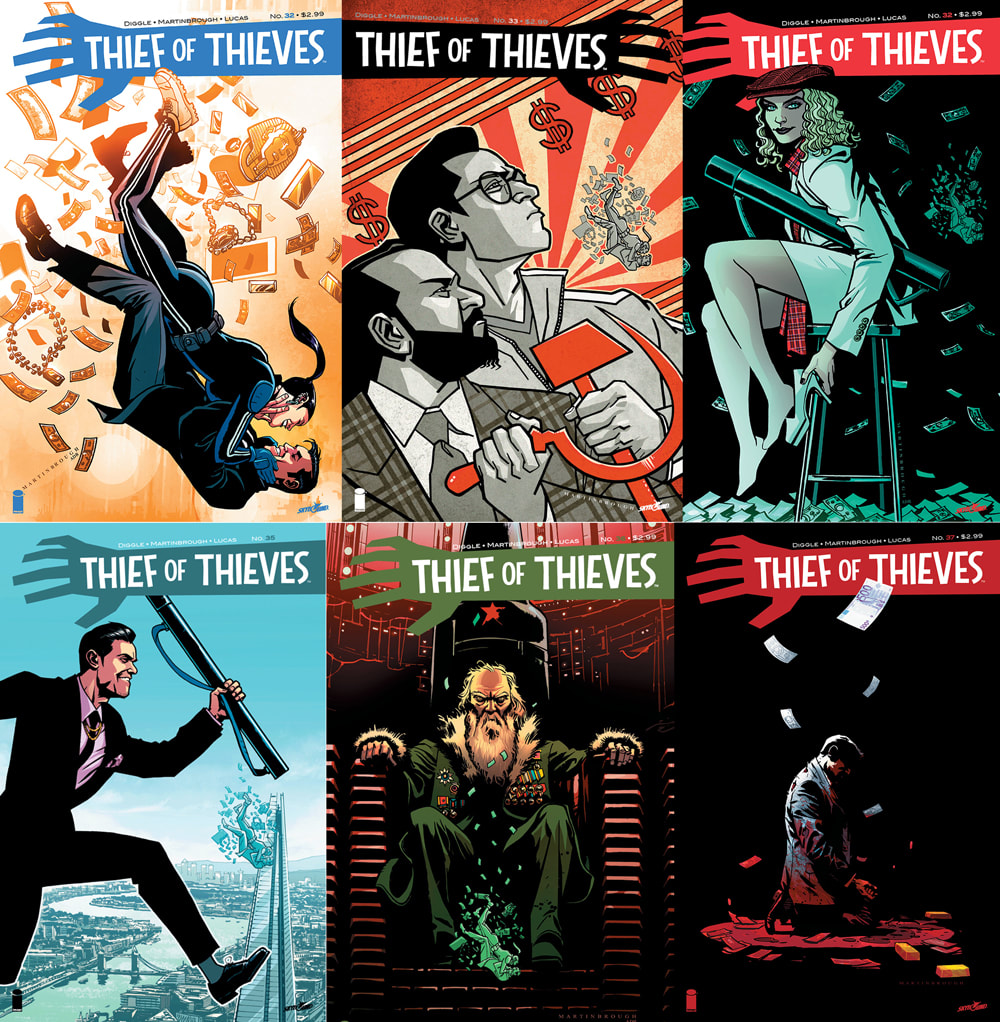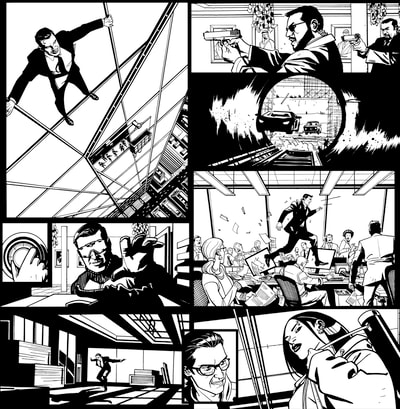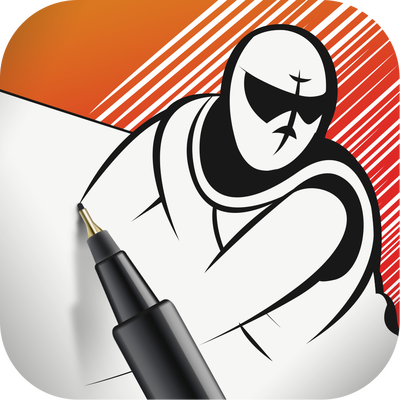
Shawn Martinbrough
“Stepping outside of one’s regular environment, interacting with new and different people and experiencing life to its fullest are the best fuel for creativity. " “Stealing or directly swiping someone else’s work is a No-No. It’s the ultimate corny move." @smartinbrough www.shawnmartinbrough.com Bio Shawn Martinbrough is the author of “How to Draw Noir Comics: The Art and Technique of Visual Storytelling.”, published by Random House and reprinted in several languages. He is a critically acclaimed creator/artist whose DC Comics, Marvel and Dark Horse Comics projects include “Batman: Detective Comics”, “Luke Cage Noir”, “Captain America”, “The Black Panther” and “Hellboy”. He is the artist of “Thief of Thieves”, published by Skybound/Image Comics. Shawn has co-created characters featured in the film, “Deadpool”, the animated “Batman: Gotham Knights”, the FOX television series “GOTHAM”, “The GIFTED” and the “JUSTICE LEAGUE” feature film. Shawn’s work has been covered by Vanity Fair, USA Today, BBC World America, The New York Times, ABC News, NBC News, The Washington Post, NPR, The Hollywood Reporter, Entertainment Weekly, BET, Essence, Ebony, The New York Daily News, AOL, Publisher’s Weekly, SiriusXM and others. Shawn has been a featured guest and panelist at comic conventions in San Diego, New York, Washington, D.C., the UK, Paris, São Paulo and Rome. As an artist, Shawn has given lectures on his career at Walt Disney Animation, Lockheed Martin, The Pentagon, TEDx Mid Atlantic, The Society of Illustrators, the School of Visual Arts, Fiorello H. LaGuardia High School of Music & Art and Performing Arts, The University of Michigan, The Savannah College of Art and Design, The 100 Black Men of America Conferences and the Book Expo of America. Inspired by Shawn’s TEDx Talk, which explored storytelling and themes of inclusion, The George Lucas Foundation consulted with Shawn to develop the Lucas Museum of Narrative Art Summer Studio. Co-hosted by the Boys and Girls Club in South Central Los Angeles, Shawn worked with a team of artists and educators to provide an intensive two week workshop culminating with each student creating their own mini comic book. Shawn is a Native New Yorker and an alum of both the Fiorello H. LaGuardia High School of Music & Art/Performing Arts and The School of Visual Arts. Being born and growing up in the Bronx. How did your experiences affect your art? During my junior high school years, I learned to paint while taking a class at my local community center in Co-op City. My teacher, Emilio, introduced me to acrylics and color theory. My formal art education began after I was accepted as an art major to the Fiorello H. LaGuardia High School of Music and Arts. In addition to being immersed in drawing and painting classes, I was interacting with a diverse school of kids from all walks of life across all the five boroughs of New York. The amount of creative and social stimuli I experienced during those years was incredible. In your How to book (How to Draw Noir Comics: The Art and Technique of Visual Storytelling) you share several exercises for artists to practice such as taking B & W pictures to develop composition skills, and drawing faces and objects with dramatic lighting. Are there any other best practices you wish to share that weren’t included in the book or that you developed after its publishing? Drawing from life is an exercise that I cannot stress enough. I regularly use photo reference for my work since I wasn’t blessed with a photographic memory to remember all of the unique details of a subject. I still use all of the techniques that I describe in my art instruction book, “How to Draw Noir Comics: The Art and Technique of Visual Storytelling”. I’m always looking to discover and be inspired by artists from across the spectrum so I love visiting museums, galleries, pop up exhibitions, street fairs, etc. Stepping outside of one’s regular environment, interacting with new and different people and experiencing life to its fullest are the best fuel for creativity. Any worst practices that artists should avoid at all costs? Copying other artists directly. We all have our favorite artists but when starting out, you have to realize that the artist whose style you admire, is usually influenced by an artist that they admire. So basically, you’re copying a copy of a copy. Stealing or directly swiping someone else’s work is a No-No. It’s the ultimate corny move. Who do you feel should/shouldn’t pursue a career in comics? If you don’t have the patience or dedication to build a career as an artist, this profession probably isn’t for you. Then again, you can apply this principle to any profession. I believe that being an artist is akin to being an athlete. You must practice every day to get better and at the same time, you must learn how to market yourself as a small business. That last part is something art schools don’t teach you. What do you recommend to aspiring artists that you wish you had known much earlier? What would you of told yourself 20 years ago? I would have told my younger self, “Make sure to create various employment options for yourself by diversifying the number of companies that you work with sooner in your career. Never get comfortable working for only one company unless, you’re the owner of that company.” What do you love best about making comics? I love the process and the art of telling stories. Solving the artistic challenge of visualizing what the writer has written on the page can be very satisfying, for the most part. Sometimes, as the artist, you never quite solve the problem to your satisfaction. You simply run out of time. Having worked with some of the best writers in the industry over the course of my career has inspired me to write my own stories. Actually, I’ve always written stories of my own. It’s been very advantageous to work alongside really talented writers and absorb some of their approaches to plotting and scripting. You had your start working with Milestone Comics. That was an incredible ensemble of artists & writers that produced remarkable content but struggled with sales and distribution plus the loss of Dwayne McDuffie. How was your experience working for Milestone? I fell into working for Milestone actually. I knew Michael Davis, one of the original founders. Years prior, Davis had introduced me and other students from his cartooning class at the Children's Art Carnival in Harlem to many professional artists working in the comic industry like Denys Cowan, Walt Simonson and Bill Sienkiewicz. Later, when Milestone was founded, I was already working as a freelance artist for Marvel. At that time, the Marvel offices were located on Park Avenue, a ten minute walk from Milestone. When I was done dropping off artwork at Marvel, I would swing by and hang out at the Milestone offices. One day, they asked if I would be interested in inking a new penciller named John Paul Leon on “Static”, one of their flagship titles. John’s art was amazing so I said sure. Over the next number of years, John and I worked together on various projects including, “Static” and “The Shadow Cabinet” for Milestone, “The Further Adventures of Cyclops and Phoenix” and “Logan” for Marvel and “The Challengers of the Unknown” for DC Comics. Working at Milestone was a really fun and empowering time in my career. A great and talented group of people. What do you wish was different about the comics industry? More diversity on the editorial side would be great. Editors are the gatekeepers for which projects get considered and which writers and artists get hired so it would be nice to have folks who are organically receptive to different voices and experiences than their own. It would be smart business as well. I also wish there would be stronger synergy between the publishers and the studios when it comes to promoting comic book sales. For example, it makes no sense that Black Panther movie made a billion dollars worldwide but the average Black Panther comic sells under 50k. This is a missed opportunity that applies to most comic book properties that are adapted to film and television. Which books do you recommend artists should have in their reference library? Favorite instructional material? This is a tough question because there are so many. “The Alex Toth: Genius Animated & Illustrated” collections are amazing. “DC: The New Frontier” by Darwyn Cooke, “Elektra: Assassin” by Frank Miller & Bill Sienkiewicz, The Fantastic Four” Omnibus by John Byrne, The “Nexus” collection by Mike Baron & Steve Rude… Top 5 favorite artists. There are too many artists that I admire and am inspired by so I can’t narrow them down to a top five. To name a few in comics, Alex Toth, Jack Kirby, David Mazzuchelli, John Byrne, George Perez, Walt Simonson, Frank Miller, Bill Sienkiewicz, Mike Mignola, Jose Luis Garcia Lopez, Tony Salmons, Steve Rude, Moebius, Jorge Zaffino, Eduardo Risso, Khary Randolph, Ron Wimberly… I could go on and on. Top 5 favorite comic characters. I haven’t had a favorite comic book character since high school. However, I find Doctor Strange, The Question, the cast of characters from “100 Bullets”, Iron Man, Doctor Doom, Galactus, Conrad Paulson and Celia (from “Thief of Thieves”) to be very compelling characters. Top 5 favorite comics and graphic novels. Again, I can’t narrow this list down to THE top five so I’ll mention some of my favorites that I feel don’t receive enough love,“Cosmic Odyssey” by Jim Starlin and Mike Mignola, “Nat Turner” by Kyle Baker, “Pride of Baghdad” by Brian K. Vaughan & Niko Henrichon, “Twilight” by Howard Chaykin & Jose Luis Garcia Lopez, “X-Men: God Loves, Man Kills” by Chris Claremont & Brent Eric Anderson. What type of work are you interested in doing in the future? More writing. Definitely some original creator owned projects that I will write and draw. I would love to return to directing. Years back, I took some time off from comics to write and direct a few short films that ended up running in several film festivals. Those were some of the most creatively fulfilling times in my life. Working with actors, scouting locations, etc. was such a creative rush. I also have interest from publishers and a few ideas for a follow up to “How to Draw Noir Comics”. I just need to nail them down. How can others find you or your work? www.shawnmartinbrough.com Instagram / Twitter : @smartinbrough Books by Shawn MartinbroughArt GalleryMedia featuring Shawn Martinbrough
0 Comments
Leave a Reply. |
Archives
November 2023
Categories
All
|



















































 RSS Feed
RSS Feed













